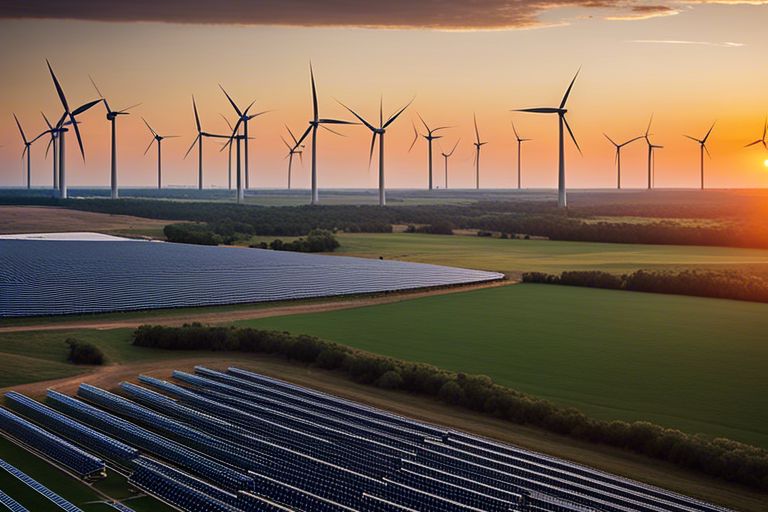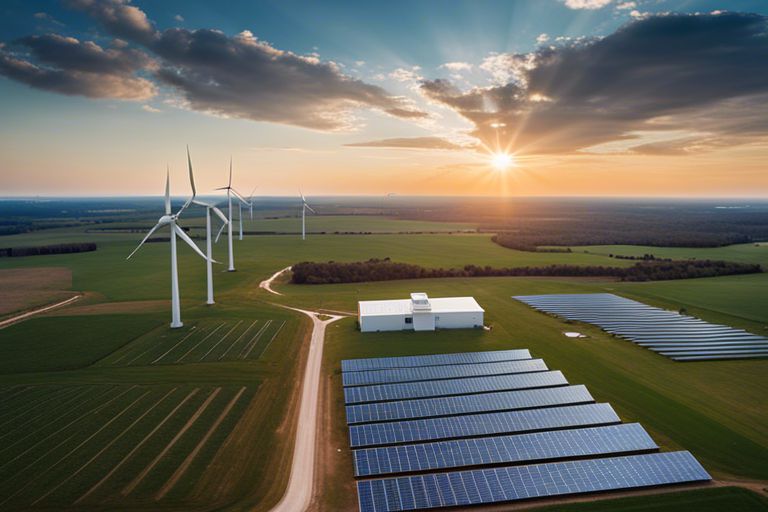Energy production and sustainability are critical topics for Oklahoma’s future, especially regarding renewable resources like biomass energy. Biomass energy, derived from organic materials such as wood, crop residue, and animal waste, plays a significant role in the state’s renewable energy landscape. With advancements in technology, biomass energy offers a cleaner alternative to traditional fossil fuels, reducing greenhouse gas emissions and promoting energy independence. Oklahoma’s abundance of agricultural and forestry resources makes it well-suited for expanding biomass energy production, contributing to a more sustainable energy future for the state. Understanding the importance of biomass energy in Oklahoma is crucial for shaping policies and investments that will drive the transition towards a cleaner, more resilient energy sector.

Key Takeaways:
- Biomass Energy potential: Oklahoma has significant potential for biomass energy production due to its vast agriculture and forestry industries.
- Renewable Energy Portfolio: Biomass energy plays a vital role in diversifying Oklahoma’s renewable energy portfolio and reducing reliance on fossil fuels.
- Economic Benefits: Investing in biomass energy can create economic opportunities for rural communities through job creation and local development.
- Environmental Impact: Utilizing biomass energy helps in reducing greenhouse gas emissions and promoting sustainability in Oklahoma’s energy sector.
- Research and Development: Continued research and development in biomass energy technologies can further enhance its efficiency and competitiveness in Oklahoma’s renewable energy future.
The Potential of Biomass Energy in Oklahoma
Agricultural Residues and Waste
The use of agricultural residues and waste holds immense potential for biomass energy production in Oklahoma. These byproducts from the agricultural sector, including crop residues, manure, and other organic waste materials, can be converted into energy through various processes such as anaerobic digestion, combustion, or gasification. Not only does this help in managing agricultural waste effectively, but it also contributes to renewable energy generation and reduces greenhouse gas emissions.
Forestry Residues and Woody Biomass
On the other hand, forestry residues and woody biomass also play a crucial role in advancing biomass energy production in Oklahoma. These resources, including branches, tops, and bark leftover from timber harvesting operations, can be utilized to produce electricity, heat, or biofuels. Utilizing forestry residues not only helps in reducing wildfire risks and promoting forest health but also provides an additional revenue stream for the forestry industry.
Biomass energy has the potential to significantly contribute to Oklahoma’s renewable energy future by utilizing agricultural and forestry residues. By harnessing these organic materials, the state can reduce dependence on fossil fuels, mitigate waste disposal issues, and create new economic opportunities for farmers and foresters. It is crucial that proper policies and incentives are in place to support the growth of biomass energy projects and further develop this sustainable energy source in the state.

Current Biomass Energy Projects in Oklahoma
Existing Facilities and Output
Even as Oklahoma continues to expand its renewable energy portfolio, biomass energy projects play a significant role in the state’s current energy landscape. Existing facilities such as biomass power plants and biorefineries are contributing to the generation of electricity and biofuels, helping to diversify the state’s energy sources. These projects leverage organic materials such as agricultural residues, wood waste, and municipal solid waste to produce energy, reducing reliance on fossil fuels.
Government Incentives and Support Programs
Biomass energy projects in Oklahoma receive a boost from government incentives and support programs aimed at promoting renewable energy development. With initiatives such as tax credits, grants, and loan programs, the state incentivizes investments in biomass infrastructure and technology. It is crucial for the growth of the biomass energy sector and aligns with Oklahoma’s broader efforts to transition towards a more sustainable and environmentally friendly energy future.
Challenges and Considerations for Biomass in Oklahoma
Economic Viability and Market Forces
Keep in mind that one of the primary challenges facing the utilization of biomass energy in Oklahoma is its economic viability in the face of market forces. An in-depth analysis of the cost-effectiveness of biomass energy production is crucial, taking into account factors such as initial investment, operational costs, and potential returns on investment. Economic feasibility studies must be conducted to ensure the sustainability and profitability of biomass projects in the state.
Environmental Impact and Sustainability
Oklahoma must consider the environmental impact and long-term sustainability of biomass energy production within its borders. This includes assessing the potential benefits of reducing greenhouse gas emissions through the use of biomass as a renewable energy source. However, it is vital to address concerns such as land use change, water consumption, and air quality impacts associated with biomass production and combustion. Proper management and regulation are vital to minimize any negative environmental consequences while promoting sustainable biomass utilization.
Biomass Energy’s Place in Oklahoma’s Renewable Mix
Integration with Other Renewable Sources
Your integration of biomass energy with other renewable sources in Oklahoma’s energy mix plays a crucial role in diversifying the state’s renewable energy portfolio. By combining biomass energy with wind and solar power, Oklahoma can create a more stable and reliable energy supply. Biomass energy can serve as a valuable complement to intermittent renewables like wind and solar, providing a steady baseload power that helps balance out the grid.
Long-term Energy Strategy and Policy Implications
One of the key factors in Oklahoma’s long-term energy strategy is the effective utilization of biomass energy. Incorporating biomass into the state’s energy mix not only reduces carbon emissions but also helps to mitigate the impacts of climate change. By investing in biomass energy, Oklahoma can move closer to its renewable energy goals while creating new economic opportunities for the state.
To ensure the successful integration of biomass energy into Oklahoma’s renewable energy future, policymakers must prioritize supportive regulations and incentives that encourage the growth of the biomass industry. Implementing strong policies that support the development of biomass projects will be crucial in achieving a sustainable energy future for Oklahoma. By fostering a favorable environment for biomass energy development, Oklahoma can position itself as a national leader in renewable energy innovation and sustainability.
To wrap up
Considering all points discussed, it is evident that biomass energy plays a significant role in Oklahoma’s renewable energy future. As a state abundant in agricultural resources, the utilization of biomass presents a sustainable and environmentally friendly solution to meet the growing energy demands. By investing in biomass energy production, Oklahoma can reduce its carbon footprint, support local farmers, and contribute to a more diversified and resilient energy portfolio. With the right policies and investments in place, biomass energy has the potential to be a key player in shaping Oklahoma’s renewable energy future for years to come.
FAQ
Q: What is biomass energy?
A: Biomass energy is a renewable energy source derived from organic materials such as wood, crops, and agricultural waste that can be used to produce heat, electricity, and fuel.
Q: How is biomass energy produced in Oklahoma?
A: In Oklahoma, biomass energy is primarily produced through the burning of wood chips, agricultural residues, and other organic materials in power plants to generate electricity.
Q: What role does biomass energy play in Oklahoma’s renewable energy future?
A: Biomass energy plays a significant role in Oklahoma’s renewable energy future by providing a reliable source of electricity that helps reduce the state’s dependence on fossil fuels and lowers greenhouse gas emissions.
Q: What are the benefits of using biomass energy in Oklahoma?
A: Some of the benefits of using biomass energy in Oklahoma include reducing waste by utilizing agricultural and forestry residues, creating local jobs in the biomass industry, and contributing to the state’s energy independence.
Q: Are there any challenges associated with using biomass energy in Oklahoma?
A: Yes, some challenges associated with using biomass energy in Oklahoma include the high costs of biomass production and transportation, the need for efficient harvesting and storage methods, and concerns about air quality and emissions from biomass combustion.
Q: How does Oklahoma support the development of biomass energy projects?
A: Oklahoma supports the development of biomass energy projects through various incentives and policies such as tax credits, grants, and renewable energy standards that encourage the use of biomass resources for electricity generation.
Q: What are some examples of biomass energy projects in Oklahoma?
A: Examples of biomass energy projects in Oklahoma include the conversion of agricultural residues into biofuels, the use of wood waste from forestry operations for heating and electricity generation, and the development of biomass co-firing projects at existing power plants.




